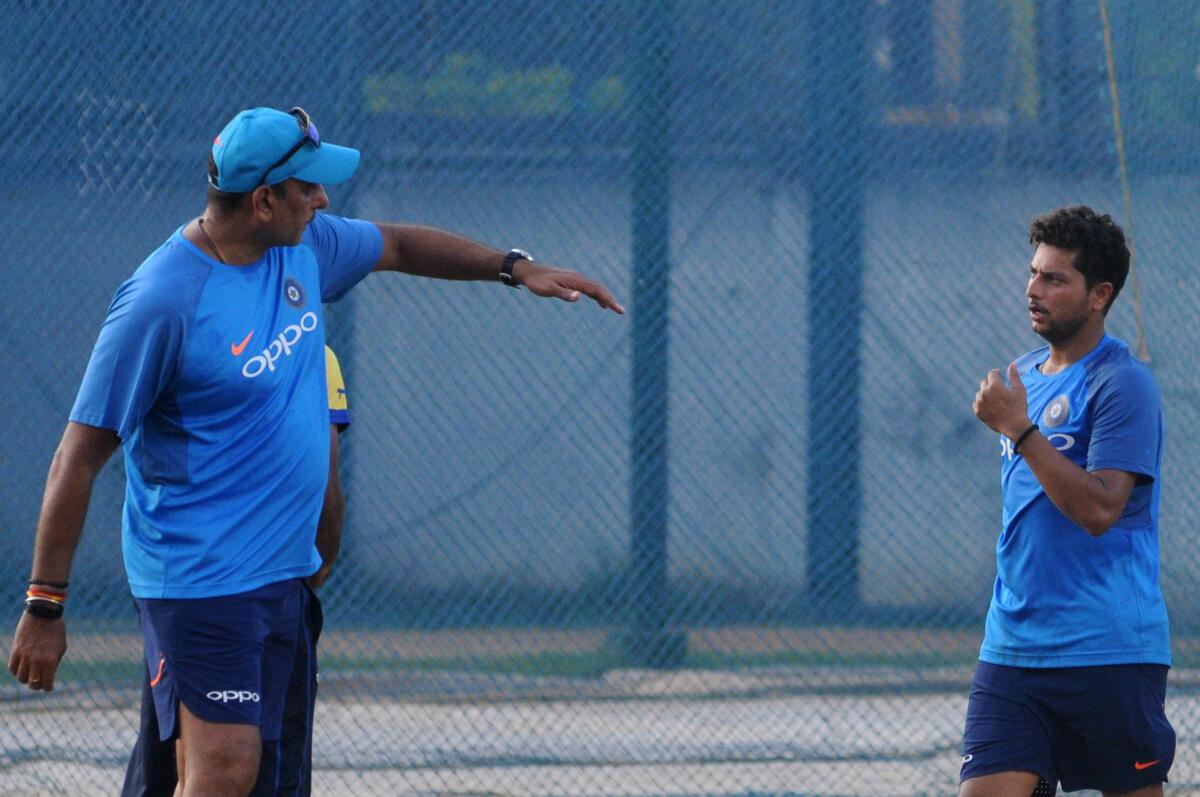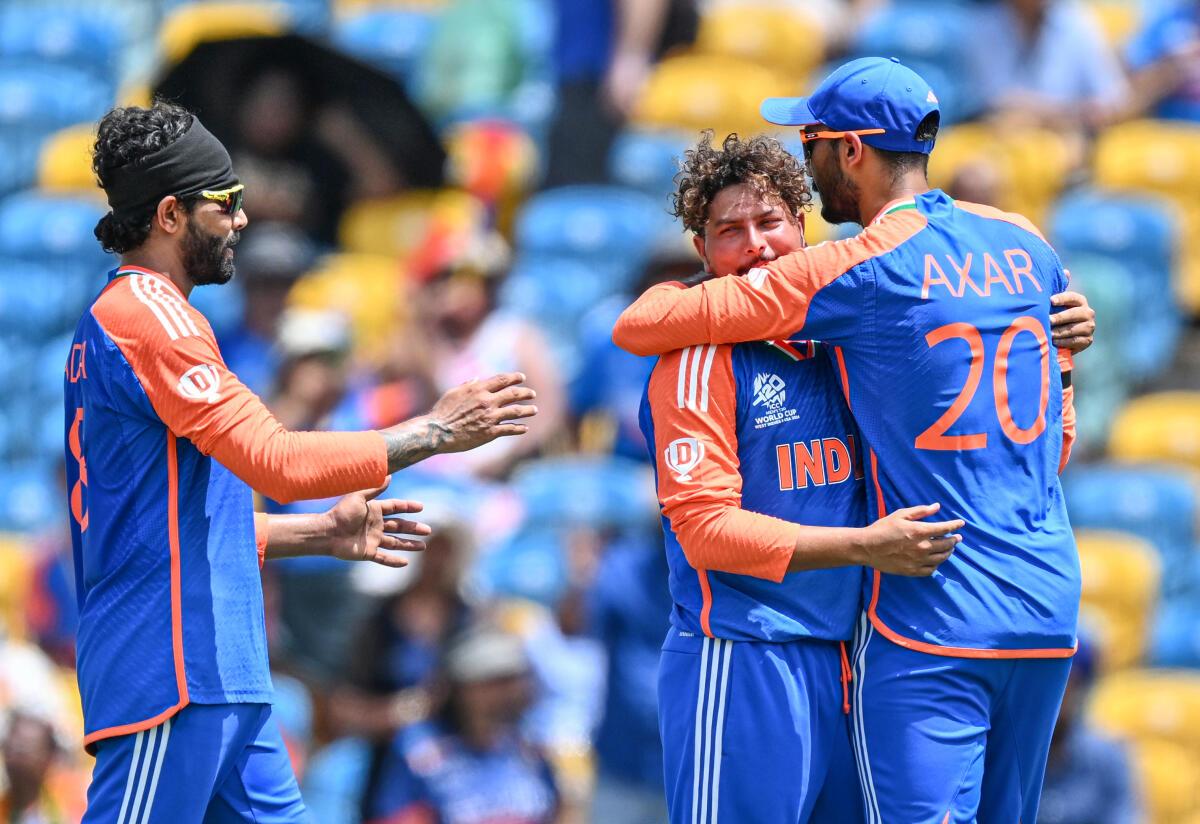Beyond the fact that they both bowl left-arm spin, there are few similarities between Ravi Shastri and Kuldeep Yadav.
Shastri was a tall and rangy orthodox spinner, using his height to procure substantial bounce; he could also turn the ball away from the right-hand batter, and became the first spinner to pick up a five-wicket haul at the WACA ground in Perth and finished his 80-Test career with 151 wickets, though within a couple of years of his debut in 1981, he had gone from a No. 10 batter to opening the innings.
Kuldeep is much shorter and a rarity in Indian cricket – a left-arm wrist spinner or, at the risk of political incorrectness, a Chinaman bowler. He is skiddy, understandably a little round-armish, his stock delivery is the one that breaks into the right-hander; Kuldeep is the practitioner of a difficult and unique craft, one that demands greater attention to detail than bowling of other ilk and where things can go awry if even one part of the body goes out of sync.
ALSO READ | Bumrah — the premier paceman of his generation
What is the common thread you ask? Their celebration. In the past, Kuldeep used a semi-chainsaw when he picked up a wicket, or defied gravity to leap high in the air. Now, as if taking wickets has become a matter of fact, he merely raises his left index finger — much like Shastri used to, but with greater drama and a more pronounced flourish to herald each of his 280 international wickets.
More than a celebration
The Kuldeep-Shastri connect doesn’t end with their celebratory routines, though. It was during Shastri’s second stint with the national side, between 2017 and 2021, that Kuldeep broke into the limited-overs firmament.
An abortive campaign in the final of the 2017 Champions Trophy – when Anil Kumble was the head coach – was the catalyst for Virat Kohli and Shastri to veer away from the finger spin duo of R Ashwin and Ravindra Jadeja in white-ball cricket and invest in wrist-spin. Thus was born an exceptional partnership between Kuldeep and Yuzvendra Chahal that bamboozled all in the two years leading up to the 2019 50-over World Cup, but was found wanting when it came to the crunch.

The famous Kul-Cha combo
| Photo Credit:
Gareth Copley
Kuldeep was an aspiring medium-pacer until his early coach convinced him to turn to spin; after all, much like Sachin Tendulkar who wanted to be a fast bowler and even attempted to impress the great Dennis Lillee at the MRF Pace Foundation, Kuldeep didn’t have the physical attributes to run in from a distance and hurl the cherry rapidly. The wisdom of that switch became apparent at the 2014 Under-19 World Cup when Kuldeep finished as the leading wicket-taker and took a hat-trick against Scotland. Before long, he was knocking on the doors of Test selection, but funnily enough, the usually attack-minded Kohli wasn’t convinced he was ready for the rigours of five-day cricket.
ALSO READ | Chokers to diamond pendants: how South Africa has turned the tide
Sporadic spells in the team
It was when Kohli missed the Dharamsala Test against Australia in March 2017 through a shoulder injury that the Test door opened for Kuldeep. Kumble convinced stand-in skipper Ajinkya Rahane of the benefits of plumping for an additional, wicket-taking bowling option with the series square 1-1 heading into the final Test. Kuldeep repaid his coach’s faith with four for 68 in Australia’s first-innings 300, his victims including David Warner, Peter Handscomb and Glenn Maxwell, all excellent players of spin.
That ought to have been Kuldeep’s coming-of-age moment. Instead, over the next year and a half, he played a mere four Tests. Then, in Sydney against Australia in January 2019, he took a five-for in a rain-ruined encounter, prompting Shastri to proclaim that Kuldeep could well be India’s No. 1 Test spinner everywhere in the world. Strangely enough, in the next two and a half years that Shastri was in charge, Kuldeep played only one Test match.

Indian cricket coach Ravi Shastri (left) with Kuldeep Yadav during a practice session at the M.A. Chidambaram Stadium, Chepauk in Chennai in September, 2017.
| Photo Credit:
B. Jothi Ramalingam
It was in the limited-overs ecosystem that Kuldeep flourished. He wasn’t a mystery bowler, so there was no real danger of him being ‘sorted’ with time. He was unconventional in that he was a left-arm wrist-spinner, but unlike Ajantha Mendis or Sunil Narine or Varun Chakravarthy, he wasn’t unorthodox. He was a mirror image of a right-arm leggie, nothing more, nothing less. That’s why he and Chahal complemented each other superbly, hunting as a pair in the middle overs of ODIs, bowling in tandem between overs 7 and 16 or so in T20 games and picking up wickets by the bushel until the pitches in England in 2019 threw a wicked curveball.
Testing times
Kuldeep quickly went out of commission, and it wasn’t just his bowling that hastened his exit from the national set-up. There were whispers of non-cricketing indiscretions, he developed the yips and was even dropped by Kolkata Knight Riders. The phase between 2019 and 2021 was the darkest of his career, with a terrible knee injury adding to his unending woes. It was a test of his mettle and character as much as of his resolve and his faith in his skills. Which tack would he take? Would he fade away, or would he dig his heels in and find his way back to the stage where he belonged? Did he have it in him?
Oh, he sure did. He sure does. Today, Kuldeep is an integral part again of India’s limited-overs set-ups, having emphatically supplanted Chahal as the No. 1 wrist-spinner; for the first time since his Test debut, he played more than two Tests in a row during the home series against England earlier this year, taking 19 wickets in four matches and helping translate a 0-1 deficit to a 4-1 rout.
It’s in white-ball cricket, though, that his pre-eminence has been nurtured and bolstered by Rohit Sharma and Rahul Dravid. Kuldeep’s stuttering career received a boost when he moved to Delhi Capitals at the beginning of the 2022 season; under Rishabh Pant and Ricky Ponting, he regained his zing, his zip, his confidence and his belief. That was further harnessed by Rohit and Dravid, aided by the fact that Kuldeep made minor changes that have increased his efficiency and made him a very potent threat on almost all surfaces.
In the last couple of years, he has added nearly seven kilometres per hour to his stock delivery. Because he is quicker through the air, he naturally reduces the batters’ reaction time. He has started to run in a little faster, gets closer to the stumps and has worked on his length, taking a cue from the magical EAS Prasanna’s treatises on bowling – ‘Line is optional but length is mandatory’. Kuldeep is reluctant to dissect his bowling at length, pun unintended, and harps on keeping it simple and not trying too hard. Simplistic as it might sound, that is the beauty of success in any field.
ALSO READ | An agonising green meltdown in a cold and damp USA
In this T20 World Cup, Kuldeep made a belated entry into the fray but has already reiterated his value with three excellent spells. When India embarked for the Americas, he was earmarked, alongside Jasprit Bumrah, as Rohit’s go-to weapons, but the pitches at the Nassau County International Cricket Stadium discouraged three spinners and India plumped for left-arm-spinning all-rounders Axar Patel and Ravindra Jadeja as insurance against batting collapses on treacherous decks. Clear channels of communication meant Kuldeep knew that once the team reached the Caribbean islands, he would instantly be pressed into service. He used the two weeks in New York to keep plugging away at the nets at Cantiague Park, probing here, teasing there, testing his wares against Rohit and Kohli, Pant and Suryakumar Yadav, Hardik Pandya and Shivam Dube, Sanju Samson and Yashasvi Jaiswal, among the best players of the turning ball in business currently.

Saving the best for last
Kuldeep was shoo-in for the Super Eights, pitchforked into battle at the first time of asking against Afghanistan, at the Kensington Oval in Bridgetown. No amount of time spent in the nets can equate to bowling in a match, and Kuldeep looked a little rusty, maybe even nervy. His first ball was an illegal delivery – horror of horrors, he overstepped! – but he bounced back to finish with two for 32. Better off for that bowl, he tied Bangladesh up in knots in North Sound on his way to three for 19 in a mesmeric, magical spell of leg-break and googly bowling.
The Daren Sammy National Cricket Stadium, and Australia, presented him his biggest challenge of the competition on an excellent batting deck and with a marauding Travis Head and Mitchell Marsh having already got their eye in when he came on in the seventh over, with 65 on the board. Bowling with and then into a stiff wind, he finished with two for 24 (economy rate 6) in a fixture that produced 386 runs in 40 overs (ER: 9.65). Bumrah up top and during the death, Kuldeep in the middle stages – Rohit’s wicket-taking as well as run-denying options haven’t let him down.
ALSO READ | A brilliant change of pace: how India went from twisting and turning to giving it unforgivingly straight
Two victories stand between India and a first global title since 2013. Up first, on Thursday in Providence, is England, among Kuldeep’s favourite opponents. In 15 international games across formats, he has 38 wickets; two T20Is have yielded five sticks at a strike-rate of 9.6 and an economy of 7.25, and it’s against the English that he boasts one of his two five-fors in T20Is. India have a score to settle with Jos Buttler’s men, having been pounded by ten wickets at the same stage in the last T20 World Cup, in November 2022. Kuldeep didn’t play then; this is his time to show them who is boss.
